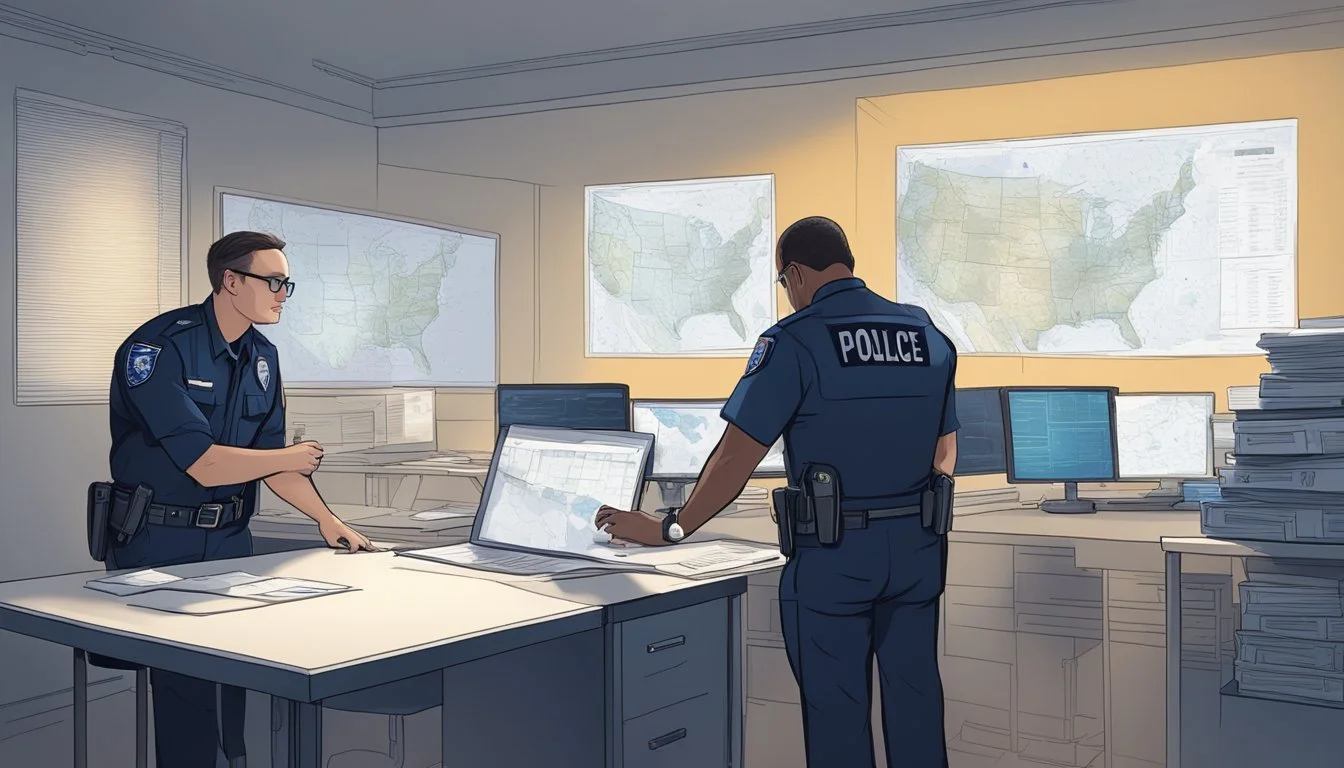Wayne Williams' Atlanta Aftermath: Child Murderer's Life Sentence Continues as Appeals Denied
Wayne Williams, convicted in 1982 for the murders of two adult men in Atlanta, continues to serve his life sentence over four decades later. His case remains inextricably linked to the Atlanta Child Murders that terrorized the city from 1979 to 1981. Though never tried for the child killings, authorities believe Williams was responsible for at least 24 of the 30 murders during that period.
The Atlanta Child Murders case gripped the nation, as young African American victims, mostly boys, were found dead across the city. Williams, an Atlanta native born in 1958, became the primary suspect after police surveillance heard a splash from a bridge where he was spotted. His arrest in 1981 marked a turning point in the investigation.
Despite ongoing controversy and debate surrounding his conviction, Williams remains behind bars. The case has been revisited multiple times over the years, with recent DNA testing conducted on evidence from two of the child murder cases. Williams maintains his innocence, but his appeals have been unsuccessful in overturning his life sentence.
Historical Context of the Atlanta Child Murders
The Atlanta Child Murders shook the city to its core between 1979 and 1981. This series of killings targeted young African Americans, primarily children and teenagers, leaving a lasting impact on the community.
Chronology of the Child Murders in the Late 1970s and Early 1980s
The murders began in July 1979 when two boys disappeared within four days of each other. Over the next 22 months, at least 28 African American children, adolescents, and young adults were killed.
The victims ranged in age from 7 to 28, with most being between 9 and 14 years old. Bodies were often found in wooded areas or rivers around Atlanta.
As the death toll rose, fear gripped the city. Parents kept children indoors, and young people traveled in groups for safety.
Impact on the Atlanta Community
The murders devastated Atlanta's African American community. Families lived in constant fear for their children's safety. Many parents implemented strict curfews and supervision rules.
The city's reputation suffered, and tourism declined. Local businesses felt the economic impact as people avoided public spaces.
Law enforcement faced criticism for their handling of the case. Some community members believed the murders weren't taken seriously enough due to the victims' race and socioeconomic status.
The tragedy brought national attention to Atlanta. It sparked discussions about race relations, poverty, and the vulnerability of marginalized communities.
The Investigation and Evidence Collection
The Atlanta Child Murders investigation involved multiple agencies, advanced forensic techniques, and extensive evidence collection. Law enforcement faced significant challenges in solving the complex series of crimes that terrorized the city.
Operation of the Task Force
A special task force was formed to investigate the Atlanta Child Murders. It included members from the Atlanta Police Department, Georgia Bureau of Investigation, and FBI. The task force coordinated efforts to track leads, interview witnesses, and analyze evidence. They set up a 24-hour hotline for tips and conducted extensive neighborhood canvasses. The group faced pressure from the public and media as the killings continued.
Task force members worked long hours, following up on thousands of leads. They created detailed profiles of victims and potential suspects. The team also utilized new computer systems to manage the vast amount of data generated during the investigation.
Role of the Atlanta Police Department and FBI
The Atlanta Police Department led the initial investigation, with detectives working around the clock. As the case grew, the FBI joined to provide additional resources and expertise. FBI agents assisted with witness interviews, evidence analysis, and profiling.
The FBI's involvement brought advanced investigative techniques to the case. They deployed surveillance teams and used wiretaps to gather intelligence. Agents also conducted extensive background checks on persons of interest.
Cooperation between local and federal agencies was crucial. Regular meetings ensured information sharing and coordinated strategy. Despite occasional tensions, the combined effort amplified investigative capabilities.
Forensic Advances and Fiber Evidence
Forensic analysis played a key role in the investigation. The FBI lab examined fibers found on victims' bodies. Using advanced microscopy, they identified unique carpet fibers linking multiple crime scenes.
Investigators collected thousands of fiber samples from suspects' homes and vehicles. They compared these to fibers recovered from victims. This meticulous process helped build the case against Wayne Williams.
Other forensic techniques included:
Hair analysis
Blood typing
Soil comparison
Tire tread matching
These methods, while not as precise as modern DNA testing, provided crucial links between victims and potential perpetrators. The fiber evidence became central to the prosecution's case against Williams.
The Suspect: Wayne Williams
Wayne Williams emerged as the prime suspect in the Atlanta Child Murders case that shocked the city from 1979 to 1981. His arrest and conviction marked a turning point in the investigation of over 20 killings.
Profile and Background of Wayne Williams
Wayne Bertram Williams was born on May 27, 1958, in Atlanta, Georgia. He grew up in the city and showed an early interest in music and media. Williams worked as a freelance photographer and aspiring music producer in his early 20s.
His interactions with local youth through his work raised suspicions during the murder investigations. Williams presented himself as ambitious and charismatic, which some believe allowed him to gain trust easily.
Law enforcement began to focus on Williams due to his frequent presence in areas connected to victim disappearances and body discoveries.
Circumstances Leading to His Arrest
Police surveillance of the Chattahoochee River on May 22, 1981, became a crucial moment in the case. Officers heard a splash and stopped Williams' car on a nearby bridge.
Two days later, the body of Nathaniel Cater was found in the river. This discovery, combined with fiber evidence from Williams' home and car, led to his arrest on June 21, 1981.
The prosecution built their case on forensic evidence, including fibers and dog hairs linking Williams to several victims. While Williams was only tried for two adult murders, authorities considered him responsible for many of the child killings.
His trial began on January 6, 1982, drawing national attention. After a lengthy proceeding, the jury found Williams guilty on February 27, 1982.
Key Events and Turning Points in the Trial
Wayne Williams' trial for the Atlanta child murders was marked by intense scrutiny and pivotal moments. The prosecution built a case around fiber evidence and witness accounts, while the defense challenged the reliability of the evidence and proposed alternative suspects.
Presentation of the Prosecution's Case
The prosecution's strategy centered on fiber evidence found on victims' bodies. FBI analysts testified that fibers matched those from Williams' home and car. This forensic evidence became a cornerstone of the state's case.
Prosecutors also highlighted Williams' suspicious behavior. They presented evidence of his late-night activities and encounters with potential victims. Witness testimony placed Williams near crime scenes and in the company of some victims before their disappearances.
The state argued that Williams' pattern of behavior fit the profile of the killer. They emphasized his access to locations where bodies were discovered and his knowledge of the area.
The Defense's Counterarguments
Williams' defense team challenged the reliability of fiber evidence. They argued that such evidence was not conclusive proof of guilt. The defense suggested that fibers could have been transferred through innocent contact or contamination.
Alternative suspects were proposed by the defense. They pointed to other individuals with criminal histories who had access to the victims. The defense team also questioned the thoroughness of the police investigation into these other leads.
Williams' attorneys highlighted inconsistencies in witness testimonies. They argued that some witnesses had changed their stories or had been influenced by media coverage. The defense aimed to cast doubt on the credibility of key prosecution witnesses.
Witness Testimony and Cross-Examinations
Witness testimony played a crucial role in the trial. Parents of victims provided emotional accounts of their children's disappearances. Law enforcement officers testified about the investigation and evidence collection processes.
Cross-examinations were often tense and dramatic. Defense attorneys aggressively questioned prosecution witnesses, attempting to expose inconsistencies. The prosecution, in turn, sought to strengthen witness credibility through redirect examinations.
Expert witnesses faced intense scrutiny from both sides. Forensic experts were questioned about the reliability of fiber analysis techniques. Behavioral experts debated the validity of criminal profiling methods used in the case.
Conviction and Aftermath
Wayne Williams was convicted of two murders in 1982 and sentenced to life in prison. He has maintained his innocence and filed multiple appeals over the years, but remains incarcerated.
Wayne Williams' Sentencing and Incarceration
On February 27, 1982, a jury found Wayne Williams guilty of murdering Nathaniel Cater and Jimmy Ray Payne. The judge sentenced Williams to two consecutive life terms. He began serving his sentence at Telfair State Prison in Helena, Georgia.
Though never formally charged, authorities linked Williams to many of the Atlanta Child Murders cases. The conviction effectively closed the investigation into the string of killings that had terrorized Atlanta from 1979-1981.
Williams is currently 66 years old and continues to serve his life sentence in a Georgia state prison. He has been denied parole multiple times since becoming eligible in 2005.
Subsequent Appeals and Claims of Innocence
Wayne Williams has filed numerous appeals since his conviction, maintaining his innocence. His lawyers have argued there was not enough evidence to convict him and alleged prosecutorial misconduct.
In 2019, Atlanta Mayor Keisha Lance Bottoms ordered a re-examination of evidence from the child murder cases. DNA testing was conducted on some items, but no new charges were filed.
Williams continues to proclaim he did not commit the murders. He has given interviews from prison asserting his innocence and claiming he was framed. However, courts have rejected his appeals and he remains incarcerated with no prospect of release.
Impact on Law Enforcement and Behavioral Science
The Wayne Williams case revolutionized investigative techniques and spurred advancements in criminal profiling. It highlighted the importance of behavioral analysis in solving complex serial crimes.
Influence on the Behavioral Sciences Unit
The Atlanta child murders case became a cornerstone for the FBI's Behavioral Sciences Unit. Agents applied psychological insights to develop a profile of the killer, helping narrow down suspects. This approach demonstrated the value of combining traditional detective work with behavioral analysis.
The case also prompted the unit to refine its methodologies. Agents studied patterns in victim selection, crime scene behavior, and post-offense conduct. These observations led to more accurate predictions about offender characteristics and motives.
Advancements in Criminal Profiling Techniques
The Williams investigation sparked significant improvements in criminal profiling. FBI profilers developed new strategies for analyzing evidence and interpreting offender behavior. They created more sophisticated models for predicting a killer's age, occupation, and personality traits.
Profilers also enhanced their ability to link seemingly unrelated crimes. By identifying common elements across multiple cases, they could better detect serial offenders. This breakthrough proved crucial in solving other complex investigations.
The case inspired the popular "Mindhunter" series, which dramatized the early days of criminal profiling. This media attention increased public awareness of behavioral analysis in law enforcement.
Cultural and Societal Repercussions
The Wayne Williams case and Atlanta Child Murders left deep scars on the city and nation. Media coverage shaped public perceptions, while artistic works explored the tragedy's impact. Decades later, the quest for justice and closure continues.
Media Coverage and Public Perception
The Atlanta Child Murders dominated news headlines from 1979 to 1981. Local and national media outlets provided extensive coverage of the killings, manhunt, and eventual arrest of Wayne Williams. This intense scrutiny influenced public opinion and heightened fears within the community.
Many residents grew distrustful of strangers and became hyper-vigilant about their children's safety. The case exposed racial tensions in Atlanta, as all victims were African American. Some criticized law enforcement's handling of the investigation, questioning whether more could have been done to protect vulnerable youth.
Literature and Film Depictions
James Baldwin's book "The Evidence of Things Not Seen" examined the murders and their impact on Atlanta's Black community. Numerous documentaries, including "Atlanta Monster," explored the case in detail. These works often questioned Williams' guilt and highlighted lingering doubts about the investigation.
Hollywood adaptations brought the story to a wider audience. The Netflix series "Mindhunter" featured the Atlanta Child Murders in its second season, reigniting public interest in the case. These depictions often focused on the psychological toll on families and investigators.
Continued Quest for Justice and Closure
In 2019, Atlanta Mayor Keisha Lance Bottoms reopened the investigation into the unsolved murders. This decision aimed to provide closure for victims' families and address lingering questions about Williams' involvement in all the killings.
DNA testing of evidence from the original cases was ordered. Some families hope these tests might exonerate Williams, while others seek confirmation of his guilt. The reopened investigation has reignited debates about racial justice and the effectiveness of the criminal justice system.
Community organizations continue to honor the victims' memories through memorials and educational programs. These efforts ensure the tragedy's impact is not forgotten and promote healing for those affected.
Current Developments and Reexamination of Evidence
Recent efforts have reignited interest in the Atlanta Child Murders case. New forensic techniques and DNA testing offer potential breakthroughs, while authorities revisit evidence and Wayne Williams maintains his innocence.
Reopening of the Case by Atlanta Authorities
In 2019, Atlanta Mayor Keisha Lance Bottoms and Police Chief Erika Shields announced a reexamination of evidence in the Atlanta Child Murders case. This decision aimed to provide closure for victims' families and address lingering questions about the investigations.
The reopening involved reviewing physical evidence and case files from the original investigations. Authorities sought to apply modern forensic techniques to potentially uncover new leads or confirm existing theories.
Mayor Bottoms emphasized the importance of using advanced technology to bring "concrete answers" to the families affected by these tragic events.
Modern Forensic Techniques and DNA Testing
Advancements in forensic science have opened new avenues for investigating cold cases. Atlanta authorities have focused on DNA analysis as a key tool in reexamining the Atlanta Child Murders evidence.
Investigators successfully extracted DNA from two child murder cases for additional analysis. This genetic material was sent to a private lab in Utah for specialized testing.
The use of modern DNA techniques offers the potential to:
Identify previously undetected suspects
Confirm or challenge existing theories
Provide new insights into unsolved cases
These efforts reflect a commitment to leveraging scientific advancements in pursuit of justice.
Public Renewal of Interest and Convicted Murderer's Parole Status
The reopening of the Atlanta Child Murders case has sparked renewed public interest. Media coverage and discussions have brought attention to the ongoing investigation and its potential implications.
Wayne Williams, convicted in connection with two adult murders and linked to several child killings, remains imprisoned. He continues to maintain his innocence and has not been granted parole.
Williams and his supporters have spoken out since the announcement of evidence reexamination. They view this development as an opportunity to challenge his conviction and potentially clear his name.
The case's reexamination has reignited debates about Williams' guilt and the possibility of other perpetrators involved in the Atlanta Child Murders.




